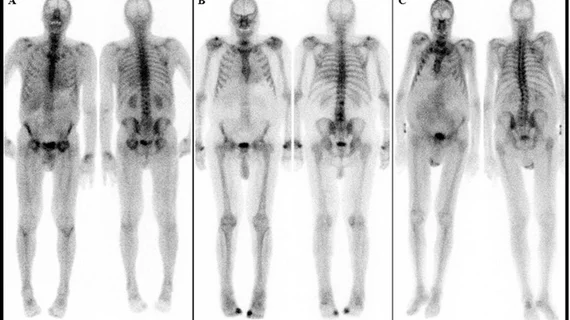Continuation of 99mTc-PYP shortage prompts need for alternative cardiac amyloidosis imaging
After three years of intermittent shortages of nuclear imaging tracer technetium-99m pyrophosphate (PYP), there are no signs of the shortage abating, according to an update from the American Society of Nuclear Cardiology (ASNC). ASNC is providing education to members interested in switching to alternative imaging methods
The PYP bone scintigraphy radiopharmaceutical was adopted for cardiac imaging because it is very good at imaging amyloid transthyretin (ATTR) cardiac amyloidosis to confirm diagnosis and enable initiation of treatment. The emergence of drug therapies have significantly improved outcomes in ATTR patients and has increased demand for this nuclear test. However, since December 2023 the radiotracer's shortage has forced providers to seek alternatives. Prior to the use of nuclear tracers for imaging to confirm the disease, endomyocardial biopsy was needed for confirm the presence of ATTR amyloid.
"Bone scintigraphy based amyloid imaging has really revolutionized ATTR amyloidosis diagnostics," explained ASNC President Panithaya Chareonthaitawee, MD, FACC, FAHA, director of the nuclear cardiology laboratory and a professor of medicine at Mayo Clinic in Rochester, Minnesota. She has seen an increasing demand for ATTR imaging over the past few years, and feels the pinch of the shortage from time to time when her lab cannot get access to the PYP kits.
She said shortages have been due to lack of a component used to make the PYP kits. The agent remains on the U.S. Food and Drug Administration (FDA) drug shortage list, impacting two vendors, Curium U.S. LLC, and Sun Pharmaceutical Industries Inc. According to the FDA website, Sun expects the shortage will persist until at least the second quarter of 2025. Neither vendor is sure when they will again have stable PYP supplies, according to the FDA’s list
Alternative to PYP imaging is HMDP
Tc99m pyrophosphate has become a standard of care for ATTR imaging. Chareonthaitawee said this is because there is already a lot of clinical data on PYP. But, she said, 99mTc-hydroxymethylene diphosphonate (HMDP or HDP) should work equally well and many nuclear labs have already made the switch to HMDP imaging as a substitute standard, or even as a replacement.
Tc99m methylene diphosphonate (MDP) should not be used for cardiac amyloidosis, as it has lower sensitivity.
"HMDP is a great alternative. Some centers have decided to only use HMDP to avoid the stops and starts with the supply of PYP. In some ways, it might be easier to change to HMDP," Chareonthaitawee explained.
She said there may slight differences in imaging protocols, but overall the image quality is similar. Chareonthaitawee said the biggest protocol difference is that some labs are using a one- hour uptake time before HMDP imaging, compared to a two- to three-hour uptake time using PYP. The optimal timing of HMDP imaging following injection is a subject of ongoing investigation by several groups.
"We intended to continue with PYP, but we may not be able to because of the continuing shortage," she explained, adding that Mayo is collecting its own research data with its use of HMDP.
In October 2022, ASNC released the information statement Radiopharmaceutical Supply Disruptions and the Use of 99mTc-Hydroxymethylene Diphosphonate as an Alternative to 99mTc-Pyrophosphate for the Diagnosis of Transthyretin Cardiac Amyloidosis. This provides guidance for making this switch to HMDP, which the society reissued links too this week.
ASNC is also hosting an upcoming webinar Optimizing the Diagnosis of ATTR-CM, which will explore how to use Tc99m-HMDP as an alternative to Tc99m-PYP with the latest guidance on acquisition, interpretation and reporting techniques. The webinar is March 18 from 6-7 pm (eastern time).

